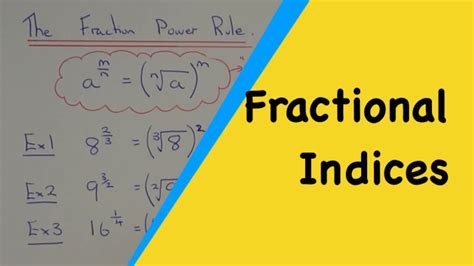1/3 To The Power Of 3 As A Fraction
News Co
Apr 07, 2025 · 4 min read

Table of Contents
1/3 to the Power of 3 as a Fraction: A Comprehensive Guide
Understanding exponents and fractions is crucial for success in mathematics. This comprehensive guide delves into the calculation of (1/3)³ as a fraction, exploring the underlying principles and providing practical examples to solidify your understanding. We'll move beyond the simple calculation to explore related concepts and applications, ensuring you gain a robust grasp of this mathematical concept.
Understanding Exponents
Before we tackle (1/3)³, let's refresh our understanding of exponents. An exponent, also known as a power or index, indicates how many times a number (the base) is multiplied by itself. For example:
- x² (x squared) means x * x
- x³ (x cubed) means x * x * x
- xⁿ means x multiplied by itself 'n' times.
The exponent dictates the number of times the base is used as a factor in multiplication.
Calculating (1/3)³
Now, let's focus on calculating (1/3)³. This means we need to multiply (1/3) by itself three times:
(1/3)³ = (1/3) * (1/3) * (1/3)
To multiply fractions, we multiply the numerators (top numbers) together and the denominators (bottom numbers) together:
(1 * 1 * 1) / (3 * 3 * 3) = 1/27
Therefore, (1/3)³ = 1/27.
Step-by-Step Breakdown: A More Detailed Explanation
Let's break down the calculation in a more methodical way, emphasizing the key steps and concepts:
-
Identify the base and exponent: In the expression (1/3)³, the base is 1/3, and the exponent is 3.
-
Write out the multiplication: Expand the expression to show the repeated multiplication: (1/3) * (1/3) * (1/3).
-
Multiply the numerators: Multiply the numerators together: 1 * 1 * 1 = 1.
-
Multiply the denominators: Multiply the denominators together: 3 * 3 * 3 = 27.
-
Combine the results: Combine the result from step 3 (the new numerator) and step 4 (the new denominator) to form the final fraction: 1/27.
Visualizing the Calculation
Imagine a cube divided into 27 smaller, equal-sized cubes. Each small cube represents 1/27 of the whole. (1/3)³ represents the volume of a smaller cube within the larger cube, which is indeed 1/27 of the whole.
Working with Negative Exponents
What if the exponent were negative? For example, let's consider (1/3)^-3. A negative exponent indicates the reciprocal of the base raised to the positive power. Therefore:
(1/3)^-3 = 1 / [(1/3)³] = 1 / (1/27) = 27
Thus, (1/3)^-3 = 27.
Applying the Power of a Quotient Rule
We can also approach this problem using the power of a quotient rule, which states: (a/b)ⁿ = aⁿ/bⁿ.
Applying this rule to (1/3)³:
(1/3)³ = 1³/3³ = 1/27
This confirms our previous calculation.
Expanding to Other Fractions and Exponents
The principles discussed above apply to other fractions and exponents as well. Let's consider a few examples:
- (2/5)²: (2/5) * (2/5) = 4/25
- (4/7)³: (4/7) * (4/7) * (4/7) = 64/343
- (1/2)⁴: (1/2) * (1/2) * (1/2) * (1/2) = 1/16
Practical Applications
Understanding fractional exponents has numerous practical applications in various fields:
-
Physics: Calculating volumes and areas, especially when dealing with scaling and dimensional analysis.
-
Chemistry: Working with molar concentrations and dilutions.
-
Finance: Compound interest calculations, where the principal amount is multiplied repeatedly over time.
-
Computer Science: Working with algorithms and data structures, particularly in areas involving scaling and complexity.
Troubleshooting Common Mistakes
When working with fractional exponents, be mindful of these common pitfalls:
-
Incorrectly multiplying fractions: Remember to multiply numerators separately and denominators separately.
-
Misinterpreting negative exponents: A negative exponent signifies the reciprocal, not a negative value.
-
Forgetting order of operations (PEMDAS/BODMAS): Follow the correct order of operations to avoid errors in more complex calculations.
Further Exploration: Advanced Concepts
For those interested in delving deeper, consider exploring:
-
Rational exponents: These involve fractions as exponents, extending the concepts discussed here.
-
Complex numbers: Exponents can be extended to complex numbers, opening up a new realm of mathematical exploration.
-
Logarithms: Logarithms are the inverse of exponents, providing a powerful tool for solving exponential equations.
Conclusion: Mastering Fractional Exponents
Calculating (1/3)³ as a fraction, and more generally, understanding fractional exponents is a foundational skill in mathematics with broad applications across various disciplines. By mastering the techniques and principles discussed in this guide, you'll gain a solid understanding of this essential mathematical concept and be better equipped to tackle more complex problems. Remember to practice regularly to reinforce your understanding and build confidence in your abilities. The more you work with these concepts, the more intuitive and easy they will become. Don't be afraid to tackle challenging problems; they are the key to truly mastering this important area of mathematics.
Latest Posts
Latest Posts
-
Parallelogram That Is Not A Rhombus
Apr 09, 2025
-
Least Common Multiple Of 8 And 15
Apr 09, 2025
-
What Percent Is 15 Of 40
Apr 09, 2025
-
What Are Prime Factors Of 99
Apr 09, 2025
-
What Is The Sqaure Root Of 45
Apr 09, 2025
Related Post
Thank you for visiting our website which covers about 1/3 To The Power Of 3 As A Fraction . We hope the information provided has been useful to you. Feel free to contact us if you have any questions or need further assistance. See you next time and don't miss to bookmark.